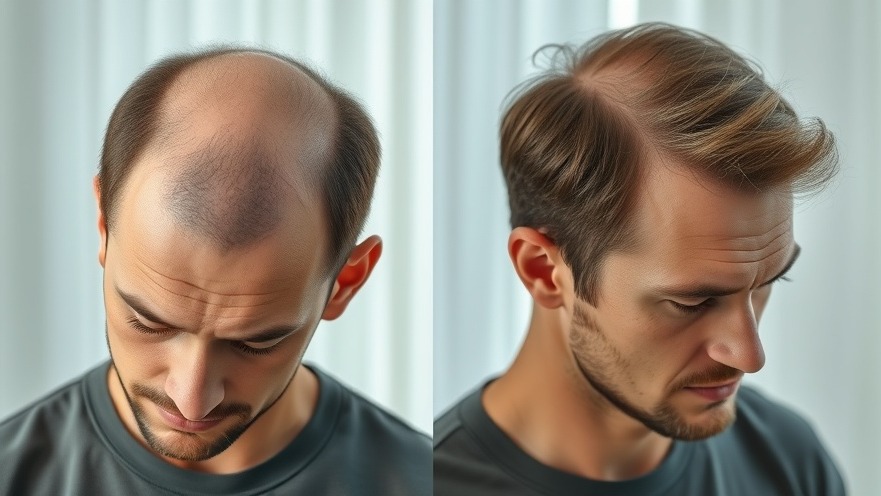
Understanding Hair Loss: The Science Behind Androgenic Alopecia
Hair loss is a common concern for many, and understanding its root causes is essential for effective treatment. The most prevalent form of hair loss is known as androgenic alopecia, often referred to as androgenetic alopecia. This condition presents differently in men and women; men typically experience hair thinning at the crown of the head, while women frequently face overall thinning across the scalp. The culprit behind this phenomenon often lies within the hormonal changes as we age, most notably the increase of dihydrotestosterone (DHT), a potent derivative of testosterone.
In 'How to Reverse Hair Loss,' the discussion dives into the science of hair growth and loss, exploring key insights that sparked deeper analysis on our end.
The Role of Follicles and Oxygen in Hair Growth
Hair follicles are complex structures that provide the 'soil' necessary for hair growth. It's crucial to emphasize that these follicles do not just produce hair; they need a rich environment, abundant in oxygen and nutrients, to thrive. Aging hormones can lead to decreased testosterone and increased DHT levels, which, when in excess, inhibit hair growth by limiting oxygen supply and promoting inflammation. Without adequate care, these follicles become damaged and scarred, resulting in shiny bald patches.
Genetic Factors and Insulin Resistance: The Hidden Influencers
While genetics play a significant role in hair loss, it’s vital to pinpoint how lifestyle factors, particularly insulin resistance, exacerbate this condition. Studies show a direct link between insulin resistance and elevated DHT levels, which further aggravates hair loss. Consequently, addressing insulin sensitivity can potentially mitigate some of these effects, emphasizing the need for a well-rounded approach to hair health.
Overlooked Therapies: What You May Not Know About Scalp Health
When it comes to reversing hair loss, many overlook simple therapies that can significantly impact scalp health. Mechanical stimulation, for instance, can awaken dormant stem cells and help break down damaging scar tissue. Techniques such as microneedling allow for better oxygen flow to the scalp, similar to how agricultural practices prepare soil for healthier crops. This stimulation can replenish the environment needed for hair follicles to flourish.
The Power of Light: Red Light Therapy and Its Benefits
Increasingly, technological advancements in health are yielding groundbreaking therapies, such as red light therapy. This innovative treatment exposes the scalp to specific wavelengths of light, enhancing mitochondrial function within the hair follicles. Health practitioners are exploring its uses not just for hair growth but also for other health improvements, indicating a promising future for non-invasive treatments.
Food for Thought: Nutritional Support for Hair Health
The nutrients you consume play an essential role in the health of your hair. Some of the most beneficial foods include liver, known for its rich heme iron content, and onions, which contain anti-inflammatory properties. Sauerkraut is also a star, packed with vitamin C and other vital nutrients, promoting good scalp health and hair growth. Additionally, incorporating pumpkin seeds can provide magnesium and other minerals necessary to combat DHT effectively.
Herbal Remedies: Nature’s Solutions for Hair Loss
Alongside dietary enhancements and lifestyle changes, certain herbal remedies have shown promise in managing DHT levels. Notable mentions include saw palmetto, pumpkin seed oil, and green tea, all of which can function as natural five-alpha reductase inhibitors. Integrating these supplements into your diet can not only enhance hair health but may also be supportive in maintaining overall wellness.
Taking Control: Actionable Steps to Combat Hair Loss
It’s clear that addressing hair loss requires a multifaceted approach. Start by identifying the root causes of your hair loss, including hormonal balances and lifestyle choices like diet and exercise. Implement habits that lower insulin resistance and give your scalp the attention it needs to thrive. Simple changes, such as incorporating micro-needling or engaging in dietary improvements, can have significant impacts over time. As you explore these solutions, remember—healing and nutrition go hand in hand.
If you wish to delve deeper into managing health struggles that may also affect your hair, consider watching the video "How to Reverse Hair Loss." With a greater understanding of the interconnectedness of health, hormones, and nutrition, you can take steps toward a healthier future.
 Add Element
Add Element  Add Row
Add Row 



Write A Comment